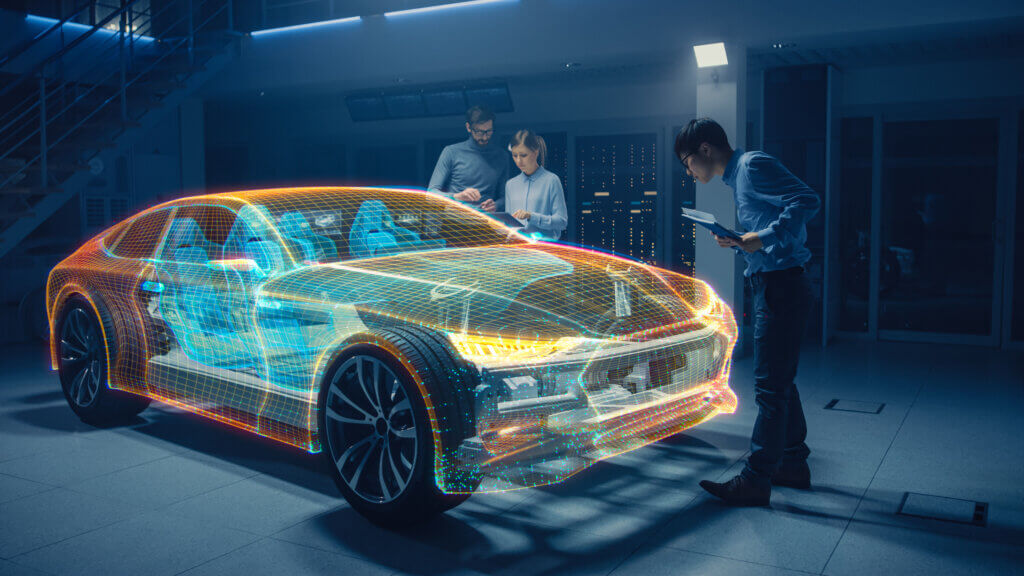Electric vehicles (EVs) have gained significant traction in recent years, and their impact extends beyond reducing carbon emissions and dependence on fossil fuels. One area where electric cars are revolutionizing the automotive industry is in-car technology. With cutting-edge features and advancements, EV manufacturers like Renault and Kia are spearheading the integration of innovative in-car tech. In this blog post, we will explore how electric cars, such as the Renault Megane E-Tech and Kia EV6, are transforming the driving experience by offering state-of-the-art technology that enhances safety, convenience, and entertainment.

Contents
- I. Enhanced Connectivity and Infotainment Systems
- II. Intelligent Driver Assistance Systems
- III. Advanced Energy Management Systems
- IV. Over-The-Air Updates
- V. Augmented Reality Head-Up Display
- VI. Intuitive Voice Control
- VII. Eco-Friendly Interior Materials
- VIII. Integration of Vehicle-to-Grid Technology
- Conclusion
I. Enhanced Connectivity and Infotainment Systems
In-car technology in electric vehicles has evolved to provide seamless connectivity and an immersive infotainment experience. The Renault Megane E-Tech boast advanced multimedia systems that offer integration with smartphones, providing access to various applications, navigation, and music streaming services. The user-friendly interfaces and intuitive controls enhance the overall driving experience, keeping drivers connected while on the road.
II. Intelligent Driver Assistance Systems
Electric cars have taken a giant leap forward in terms of safety, thanks to the integration of intelligent driver assistance systems (ADAS). Kia EV6 come equipped with cutting-edge ADAS features such as adaptive cruise control, lane-keeping assist, and automatic emergency braking. These systems work in harmony to enhance driver safety, reduce the risk of accidents, and provide a more relaxing driving experience.
III. Advanced Energy Management Systems
Electric vehicles require efficient energy management systems to optimize battery usage and extend driving range. The Renault Megane E-Tech and Kia EV6 utilize sophisticated energy management systems that monitor battery health, analyze driving patterns, and provide real-time energy consumption feedback. These systems not only maximize the driving range but also enable drivers to plan their trips more effectively, ensuring they reach their destinations without range anxiety.
IV. Over-The-Air Updates
Gone are the days when you had to take your car to a service centre for software updates. Electric vehicles are equipped with over-the-air (OTA) update capabilities. OTA updates allow manufacturers to remotely update the car’s software, introducing new features, bug fixes, and performance improvements. This feature ensures that your car’s technology is always up to date, providing an enhanced driving experience without the need for manual intervention.
V. Augmented Reality Head-Up Display
Electric cars are embracing augmented reality (AR) to revolutionize the traditional head-up display (HUD). The Renault Megane E-Tech and Kia EV6 feature advanced AR HUD systems that project important information onto the windshield, directly in the driver’s line of sight. This technology overlays vital information such as speed, navigation instructions, and even collision warnings onto the real-world view, making driving safer and more convenient.
VI. Intuitive Voice Control
Voice recognition technology has come a long way, and electric cars are leveraging this advancement to offer intuitive voice control systems. Drivers can control various in-car functions, such as climate control, navigation, and multimedia, simply by using voice commands. This hands-free approach enhances driver safety and convenience, allowing drivers to keep their attention on the road while still accessing important features.
VII. Eco-Friendly Interior Materials
In addition to advanced technology, electric cars are also prioritizing eco-friendly interior materials. Sustainable and recycled materials are being used in the construction of seats, dashboard panels, and other components. This focus on environmentally friendly materials aligns with the overall mission of electric vehicles to reduce their carbon footprint and promote sustainability. By integrating these eco-friendly materials, electric cars are creating a holistic and eco-conscious driving experience.
VIII. Integration of Vehicle-to-Grid Technology
Electric cars are not just consumers of electricity; they can also act as energy sources. Vehicle-to-Grid (V2G) technology enables electric vehicles to discharge power back into the grid when parked and not in use. The Renault Megane E-Tech and Kia EV6 are at the forefront of implementing V2G technology, allowing owners to use their vehicles as energy storage units that can power their homes or provide electricity to the grid during peak demand periods. This integration of V2G technology not only maximizes the utilization of renewable energy but also provides economic benefits to EV owners.
Conclusion
Electric cars are transforming the automotive industry by introducing revolutionary in-car technology. The Renault Megane E-Tech and Kia EV6 are prime examples of electric vehicles that incorporate cutting-edge features to enhance safety, connectivity, and convenience. With enhanced connectivity, intelligent driver assistance systems, advanced energy management, OTA updates, augmented reality HUDs, and intuitive voice control, these electric cars are redefining the driving experience. As electric vehicle technology continues to evolve, we can expect even more innovative in-car tech to further revolutionize the way we interact with our vehicles.



